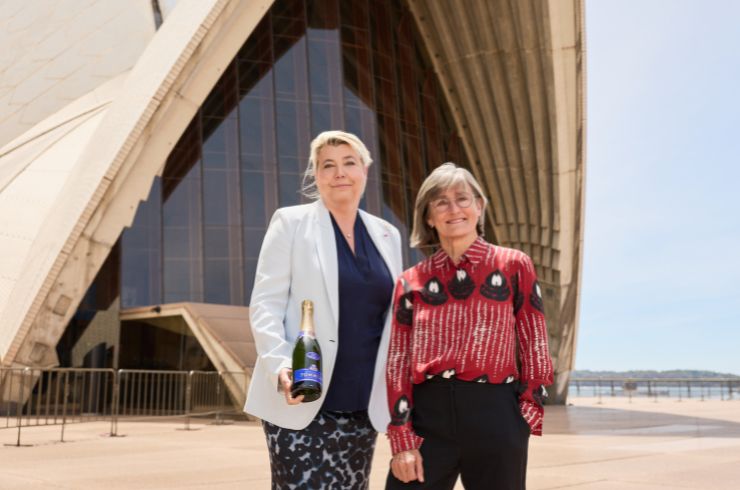“It better be bloody good!”
The words of Patricia Brown, the late Brown Brothers matriarch, hang heavy at every classification tasting for the wines that take her name.
Each wine can’t be anything other than “bloody good.”
Senior winemaker, Cate Looney, knows full well the pressure to succeed. Her fellow winemaker and Brown Brothers Portfolio Manager, Katherine Brown, is Pat’s granddaughter.
Katherine and her sisters, Caroline (Corporate Communications Manager) and Emma (Head of Innovation), have a deep connection in maintaining the the legacy of their grandmother who died in 2004, aged 89. No pressure.
Katherine remembers a woman who wasn’t one to sit around and was often to be seen in the winery. Was Pat, as she was known, taken aback by the decision to use her name on a range of wines?
“I think she was very surprised,” says Katherine, “and by the fact that ‘her boys’ had come to her to ask permission.” It was, in essence, a thank you.
One of the stars of the Patricia range of wines is chardonnay which, for the last decade, has been sourced exclusively from Tasmania.
After Brown Brothers bought 400 hectares of vineyards in Tasmania’s Tamar Valley and East Coast from Gunns in 2010, it took some time to get to know the sites, the vines and the styles the company wanted to pursue.
“It takes so many years for a winemaker to just feel comfortable,” explained Cate during a recent tasting to celebrate 10 years of Patricia Tasmanian Chardonnay.
“Over time we changed some things. It used to be sparkling wine (sites) and we flipped them to table wines. It’s actually some of the best fruit, which is great for our sparkling program, but we have done a lot of thinking about both sites that are there.”
The winemaker has the luxury of being able to source fruit from either or both Tasmanian vineyard sites – the Tamar Ridge vineyard at Kayena in the Tamar Valley in the north of the state, and the Hazards Vineyard at Devil’s Corner on the East Coast.
Three years after buying into Tasmania, the first vintage was gearing up in 2013 but, in the words of the winemaker, “it wasn’t coming together as a Patricia.” But in 2014, the time was right.
In the tasting, the first two vintages – 2014, 2015 - were tasted together. “They are maybe a little more classic in winemaking, a bit more straight up and down,” explains Cate.
“They were barrel fermented, and they were probably picked a little riper.”
In 2016, early concerns over smoke taint (which never appeared) saw the wine de-classified and downgrade to a Limited Release.
By 2017, Cate and the team were feeling a little more comfortable in their new surroundings.
“We are understanding the sites, pulling back the picking baumé (sugar levels). Where we were getting 13.5 per cent ABV, these are more 12.5 per cent ABV or slightly lower,” she notes.
“I think you are seeing this beautiful purity of acidity running through these wines. They are all hand-picked, whole bunch pressed and all barrel fermented, and there is more experimenting with different barrels and different yeasts.”
The oak is all French from a range of coopers, all barriques (225L) and around 30–35 per cent new. And, by now, Brown Brothers winemakers are getting used to the higher levels of acidity to be found in such cooler climates.
“It’s totally different to what you might choose (winemaking-wise) for a chardonnay from, say, the Yarra Valley – a little bit of lees stirring, MLF in barrel and anywhere between nine and 12 months in oak.”
From 2017 onwards, the style was largely set. Cool-climate Tasmanian acidity becomes the driver of the style. The wines, adds the winemaker, are “truly ageworthy.”
For Katherine Brown, the role of secondary characters from barrel fermentation bring forward a character she personally loves to see in Patricia chardonnay – a flinty and cashew-like nuttiness. “I’ve got a real passion for that flinty character, that sulphide-y character,” she says. “Cate and I disagree sometimes on just how far you can push sulphides, but that 2018 (Patricia Chardonnay) is my absolute go-to, I just love that layer, those layers of complexity that the barrel ferment really brings to it.”
It has been estimated that growing and making wine in Tasmania can be anywhere between five and 10 times more expensive than on the mainland. That estimate is supported by research conducted by Wine Tasmania which has found, among a host of expensive differences, that grape prices in 2025 on the island were $3924/tonne compared to the national average of $604/tonne, while the number of workers required to manage 1000ha of vineyard in the state is 122 compared to, say, NSW where the number is 22.
Why did Brown Brothers make the decision to move into Tasmania? Bushfires across parts of Victoria in 2007 and 2009 affected both company vineyards and growers in the five regions where Browns sources fruit. The board decided it was time to diversify and spread the risk.
“It also helped that Dad (Ross Brown) really loved fly fishing and that was the big motivator for him to go and do some research,” says Katherine.
Would her grandmother have been happy having a Tassie chardonnay take her name?
“I do think the chardonnay would be one of her favourite wines,” she suggests. “I wish I was old enough to enjoy a wine with her before she died so I could have asked her this question.”
Brown Brothers Patricia Tasmanian Chardonnay
2014
Pristine with a pure essence of citrus at its heart, the role of Tassie’s assertive, cool climate acidity is on show. It belies its 11 years in the bottle. Delivers fine, mineral flecked citrus fruits with baked quince, just-ripened stone fruits, toasted nuts and lantana. The palate is fine, precise and linear. A restrained chardonnay from a cool vintage. 92pts.
2015
Concentrated chardonnay aromas in peach, ripe melon, nectarine stone fruits, citrus and white flowers. Inviting and textural with layers of smooth, creamy chardonnay white stone fruits, citrus, gentle spice and vanillin oak. Carries impressive ripeness on the palate and weight cut clean by bright acidity through to the finish. So youthful. 94pts.
2016
Declassified.
2017
A stand-out vintage in Tasmania and it shows in the glass. An impressively fragrant and elegant chardonnay with superb, sustained flavour. Offers a wealth of white peach and stone fruit, tangy, flinty flavours with citrus, grilled cashew nuttiness, vanillin toasty oak and cardamon spices rolling across the palate amid crunchy bright acidity. Totally integrated, totally irresistible. 96pts.
2018
A big picture chardonnay (by Tassie standards), expansive and expressive. Brings together white flowers and spring blossom, stone fruits through to light tropicals with a citrus and flinty complexity, hints of grilled nuts, and lively in spice. The palate is smooth and sleek, warm in texture, running long with a fine focused finish. 95pts.
2019
Starts quietly and then builds. A warmer vintage on the island leads to a generosity of expression with spiced apple and pear appearing alongside stone fruits and citrus, grilled hazelnuts and mealy notes, with a rising and exotic touch of ginger spice aromatics. Nicely complex and delivered against a tight framework of acidity. 95pts.
2020
The fruit shines in delicious stone fruits and members of the citrus family, together with a bright splash of beachy rock-pool notes. Flavours run deep and long, intensified on the palate through the delivery of cool-climate zippy acidity. Smart use of oak here with an attractive almond-nougat intervention through the middle palate. 95pts.
2021
Imparts a coiled but focused presence in the glass. Combines filigree-fine acidity with equally fine, subtle fruit intensity, a lick of spice and oak-defined almond mealiness. Will continue to build and age well. Winemaking is exemplary. 95pts.
2022
Sets the scene with scintillating lifted aromas in wildflowers, blossom, lemon and stone fruits. Gets super interesting on the palate with Tasmanian acidity, pristine and fruit-tingly bright, working the tastebuds in collaboration with layers of citrus, lemon curd, nougat and hazelnut. Great composure, concentration and texture. 100% Kayena Vineyard. 95pts.
2023
Plenty of flavour concentration in the ’23 release with ripe nectarine, white peach and citrus fruits with hints of white flowers, nougat, light, cashew oak, sea spray, crushed stone, lemon zest and crème fraîche. There is a wonderful clarity and drive with brisk saline cadence tightening things up on the palate and the lightest textural slinkiness.100% Kayena Vineyard. – Dave Brookes, 95pts.
Order your copy of the 2026 Halliday Wine Companion today
The 2026 edition of the seminal guide to Australian wine, the Halliday Wine Companion, is on sale now. Secure your copy today, or upgrade to a Vintage Halliday membership.
Latest Articles
-
![Default article tile image]()
News
Melbourne-Royal-Wine-Awards-2025
12 hours ago -
News
A yin and yang of opulence and restraint: 15 vintages of Yangarra High Sands
1 day ago -
News
Champagne Pommery named official Champagne Partner of the iconic Sydney Opera House
13 Nov 2025 -
Travel
How to spend 48 hours in the Hunter Valley
13 Nov 2025





